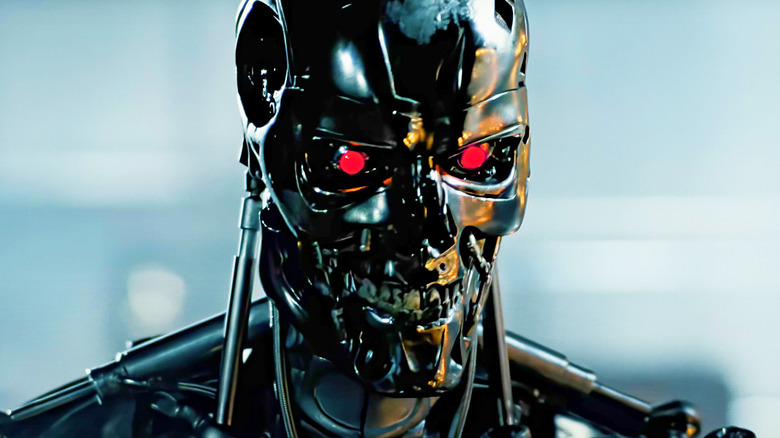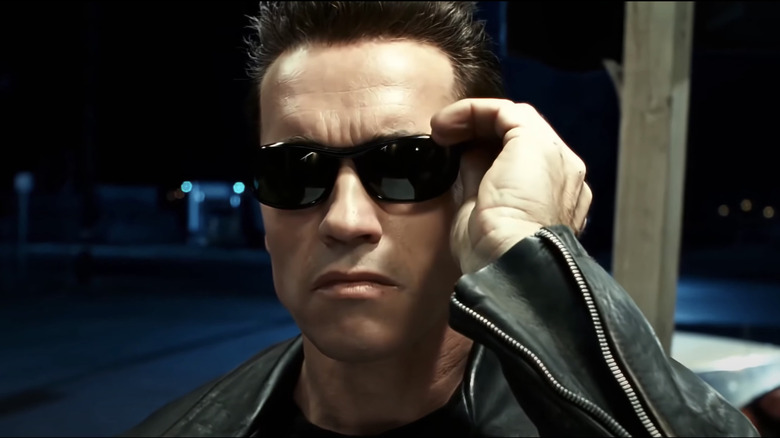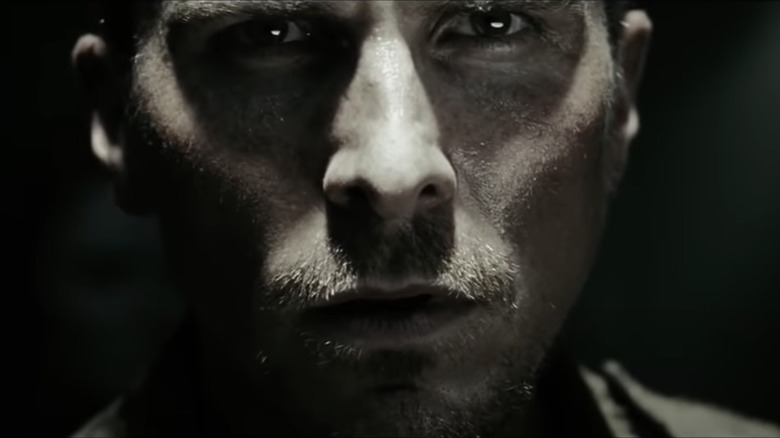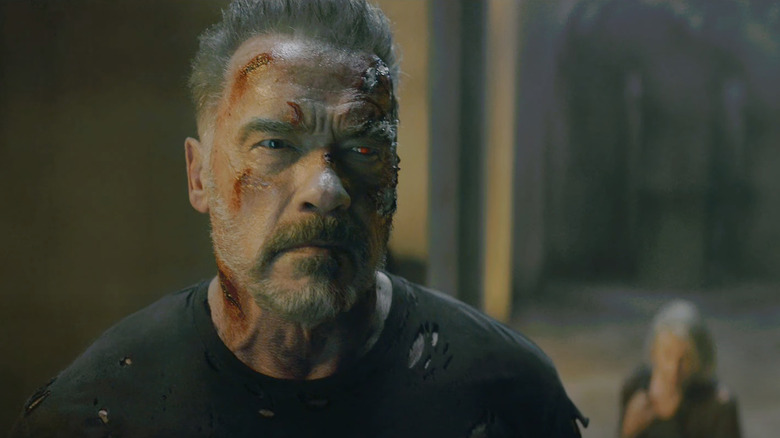The Correct Order To Watch The Terminator Movies
When Arnold Schwarzenegger delivered the now legendary line, "I'll be back," in 1984's "The Terminator," no one could have known how true that statement would prove to be. Arnie was indeed back, and back, and back, and back, and back again, proving that the only thing as relentless as the T-800 is Hollywood's desire to pump out sequel after sequel.
Thankfully, we at least got one classic of the action genre out of it: 1991's "Terminator 2: Judgment Day." After delivering a masterpiece of low-budget sci-fi filmmaking in '84, director James Cameron proved why he's the king of sequels with the 1991 follow-up. "T2" outdid its predecessor in almost every way, blending impeccable action set pieces with an overwhelming sense of doom that made the film linger in the mind long after viewing.
After that, the films continued without Cameron, and not only was there a marked drop in quality with every Terminator movie after "T2," there were all sorts of timeline shenanigans that have left the franchise a twisted wreck amid the dystopian future we now find ourselves in — only this one has been wrought not by a hyper-aware superintelligence, but by Hollywood itself.
All of which has probably left the uninitiated, or even those who haven't watched the 6 "Terminator" films in a while, a little confused. If you're considering delving into this nebulous cloud of a franchise, you might consider reading on to figure out where exactly you're supposed to start and how best to proceed through the various sequels and reboots.
The Terminator films in production order
To keep things simple, we'll start out with the films in their production order. This is a perfectly legitimate way to watch the saga as you'll get a full appreciation for how many dang times studios have tried and failed to reinvigorate the Terminator franchise. It's also a good way to completely overlook the misguided attempts to rewrite Cameron's original timeline and simply witness the films in the order they arrived — an act of pure viewing defiance, if you will. What's that, "Terminator: Dark Fate"? You're a direct sequel to "T2"? Not in this rewatch you're not! Here are the Terminator films in the order they were released:
-
"The Terminator" (1984)
-
"Terminator 2: Judgment Day" (1991)
-
"Terminator 3: Rise of the Machines" (2003)
-
"Terminator: Salvation" (2009)
-
"Terminator: Genisys" (2015)
-
"Terminator: Dark Fate" (2019)
As you can see, there were some big gaps between certain films, suggesting that at several points Hollywood went back to the drawing board and really tried to figure out where to take this historic franchise next. Sadly, nobody has yet cracked that particular conundrum, and the sequels seemed to get worse as they came — though the most recent film, "Terminator: Dark Fate" does have its defenders. Still, there's a reason star Arnold Schwarzenegger is done with the Terminator movies — that reason being that they're just not very good now. Or, as Arnie put it, "just not well-written."
Still, if you're intrigued as to how the various sequels fit together, allow us to offer you some alternate viewing orders that come as close to chronological as you can get with this franchise.
The first Terminator 'Chronology'
After 1991's "Terminator 2," we had to wait a full 12 years before we got a follow-up. While rights issues were partly to blame, I'd like to think the sheer action majesty of James Cameron's Terminator sequel basically necessitated more than a decade of cooling off, whereby no filmmaker, including Cameron himself, was allowed to sully the perfect record of this burgeoning franchise.
Of course, there did come a threequel in 2003. "Terminator 3: Rise of the Machines" might not have been all that great, but it thankfully kept continuity with the previous film. As did the next movie (sort of). 2009's "Terminator: Salvation" switched things up by taking us directly into the future war, following an adult John Connor as he led the human resistance in an attack on Skynet's base. It wasn't all that memorable an entry, and star Christian Bale even regrets being a part of it, but at least you can watch through from the original "Terminator" to "Salvation" and things will pretty much make sense. "Salvation" could technically be seen as a prequel to the first movie, and it's often cited as a soft reboot for the franchise. But rather than getting bogged down in these timeline specifics, it's easiest and perfectly valid to think of Salvation as a sequel to "T3."
So that's one Terminator timeline taken care of. After "Salvation," things take an even more confusing turn (more on that later). For now, though, watching through from "The Terminator" to "Salvation" will complete the initial Terminator timeline, and if you call it quits there, we wouldn't blame you. For completionists, read on to find out how the other films fit into the in-universe timeline.
Genisys and Dark Fate
When 2015's "Terminator: Genisys" arrived it rewrote the Terminator playbook, rebooting the franchise by inventing a wholly separate timeline. In this alternate timeline, the T-800 from the original movie was actually sent back to 1973, not 1984, and became Sarah Connor's kindly protector, affectionately known as "Pops." You might be starting to understand why "Genisys" was not the franchise's triumphant resurgence.
Without getting too bogged down in the needlessly confusing timeline trickery, "Genisys" can be viewed as a standalone entry in the Terminator saga, despite the fact there were several "trippier" sequels planned. However, the film is inexplicably concerned with aping moments from James Cameron's first movie, making for a bewildering mix of reinvention and homage. So feel free to watch this one whenever the heck you like — though it'll probably make a bit more sense to watch it after the original "Terminator" so that the nostalgia plays scan.
That just leaves "Terminator: Dark Fate," which was supposed to restore the Terminator franchise to greatness. Unfortunately, despite bringing back Linda Hamilton's Sarah Connor and recruiting James Cameron as producer, Tim Miller's 2019 effort was yet another misstep in the series. But if you simply have to complete the saga, then "Dark Fate" is supposed to be a direct sequel to "T2." Ignoring the events of "Terminator 3," "Salvation," and "Genisys," "Dark Fate" sets itself up as the true follow-up to Cameron's original films. As such, you can go direct from "T2" to "Dark Fate" and the timeline should make sense. That said, Miller's legacy sequel does start with a sequence that effectively renders the events of "T2" pretty much meaningless — you have been warned. Let's hope Cameron comes through with that AI-focused "Terminator" movie that may or may not actually materialize.



